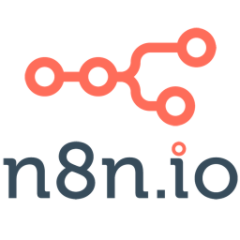n8n Cloud
Connect n8n Cloud's powerful workflow automation platform with Webflow to create sophisticated automations, sync data across multiple tools, and build complex business processes.

How to integrate n8n Cloud with Webflow
Automate content synchronization between Webflow and other tools without writing code. n8n Cloud connects Webflow forms to CRMs, syncs blog posts from content platforms, and routes leads to sales teams automatically.
You can integrate n8n Cloud with Webflow using the built-in Webflow node for visual workflows, or use both platforms' APIs for custom automations that need version control or dynamic workflow generation.
Use n8n's Webflow node
n8n's built-in Webflow node provides visual, no-code access to core Webflow operations through a drag-and-drop interface. Connect your Webflow account using OAuth authentication, then automate CMS operations without writing code.
The node supports these operations:
- Create items in any Webflow collection to add blog posts, products, or custom content
- Update existing items based on triggers from other apps or scheduled intervals
- Delete items to maintain data consistency across platforms
- Retrieve single or multiple items for reporting, backup, or migration purposes
Popular pre-built templates accelerate common integrations:
- Notion to Webflow sync automatically publishes blog posts when content is ready
- AI-powered FAQ enrichment uses OpenAI or Claude to expand basic questions into comprehensive answers
- Real-time lead routing sends form submissions to CRM systems with enrichment and scoring
For operations beyond the standard node capabilities, use the HTTP Request node with your existing Webflow credentials to access any API endpoint.
Build with Webflow and n8n Cloud APIs
Integrating n8n Cloud and Webflow through APIs enables programmatic workflow management, custom triggers, and integration with existing development workflows. This approach suits teams needing version control, CI/CD integration, or dynamic workflow generation based on business logic.
Key capabilities include:
- Programmatic workflow creation and management through REST endpoints
- Custom execution triggers that respond to specific business events
- Credential management for secure, centralized authentication
- Health monitoring for production reliability
Create dynamic workflows
Build and modify workflows programmatically to scale automation across multiple sites or adapt to changing requirements:
- Generate workflows via API using
POST /workflowsto create workflows from templates or business logic, enabling multi-site deployments - Update workflow configuration by modifying nodes, connections, and settings through
PATCH /workflows/:workflowIdbased on external triggers - Monitor execution status by tracking workflow performance using
GET /executions/:executionIdto ensure reliable operation
The n8n API documentation provides complete endpoint specifications, authentication patterns, and response schemas for building robust integrations.
Implement webhook-driven automation
Connect Webflow forms and events directly to n8n workflows for real-time processing:
- Configure webhook triggers so each n8n workflow exposes a unique webhook URL that Webflow forms can target
- Process form data by transforming, validating, and routing submissions to multiple destinations like CRMs, email systems, or databases
- Handle complex logic using n8n's branching, conditions, and error handling to create routing rules
The n8n webhook documentation details security options, payload handling, and response customization for production deployments.
Automate content operations
Synchronize Webflow CMS with external data sources using API-driven workflows:
- Bulk content import by creating workflows that read from databases or APIs and populate Webflow collections using
/collections/{collection_id}/items - Scheduled synchronization to update product catalogs, blog posts, or portfolios on regular intervals using n8n's schedule triggers
- Multi-platform publishing to distribute Webflow content to social media, email campaigns, or other CMS platforms automatically
The CMS sync documentation provides field mapping examples and best practices for maintaining data integrity.
What you can build
Integrating n8n Cloud with Webflow enables automation across marketing, operations, and content management.
- Automated content publishing pipelines sync blog posts from Notion or Google Docs to Webflow CMS, with automatic formatting, image optimization, and SEO metadata generation through AI services
- Lead enrichment workflows capture Webflow form submissions, enrich with data from enrichment providers, score leads, and route to appropriate sales teams in HubSpot or Salesforce with customized follow-up sequences
- E-commerce automation synchronizes product catalogs between Webflow and inventory systems, automates order processing to fulfillment platforms, and triggers customer communications based on purchase behavior
- Multi-channel marketing campaigns publish new Webflow content automatically to social media platforms, trigger email campaigns, and update marketing dashboards with performance metrics from multiple sources
Frequently asked questions
In n8n's credential manager, create new Webflow credentials using OAuth authentication. Click Connect my account to authorize n8n through Webflow's standard authentication flow. The credentials are encrypted and can be reused across multiple workflows. For API token authentication, refer to the credential setup documentation.
Use n8n's HTTP Request node with your existing Webflow credentials to access any API endpoint. Set the authentication type to "Predefined Credential Type" and select your Webflow credentials. The Webflow API documentation provides endpoint details for custom operations.
Yes, configure a webhook trigger in your n8n workflow to generate a unique URL. In Webflow, set your form's action to this webhook URL. Form submissions automatically trigger the workflow. The webhook setup guide explains security options and data handling.
n8n provides visual error handling through branching nodes. Add error outputs to Webflow nodes to catch failures, log details, and implement retry logic or notifications. The execution history shows complete error details including status codes and messages from Webflow's API.

Description
n8n Cloud is a managed workflow automation platform that enables users to connect apps, data, and AI tools through visual workflows. It offers a drag-and-drop interface for building complex automations with over 1,000 integrations, custom code support, and enterprise-grade security hosted on Microsoft Azure infrastructure.
This integration page is provided for informational and convenience purposes only.

Claude
Webflow's Model Context Protocol (MCP) server connects Claude AI directly to your site's CMS, Designer APIs, and data layer.
ChatGPT
Direct API integration provides complete control over AI functionality compared to pre-built solutions, enabling custom conversation flows, context management, and advanced processing patterns that aren't possible through standard embeds.

Zapier
Share data between Webflow and third-party apps using Zapier.

Freshdesk
Embed Freshdesk's Help Widget directly on your Webflow site to add a floating widget to your pages where visitors can submit tickets, search help articles, and check ticket status.

Shipmondo
Connect Shipmondo with Webflow to automate order fulfillment and multi-carrier shipping from your e-commerce store.

IFTTT
Connect Webflow to over 900 apps and services through automated workflows. IFTTT routes form submissions to CRMs, syncs content from RSS feeds to your CMS, and triggers email marketing campaigns without custom code.

Microsoft Copilot
Microsoft Copilot connects to Webflow through embedded chat interfaces or API calls. No official Webflow marketplace app exists, so you'll use code embeds or build custom API integrations.

monday.com
Connecting monday.com with Webflow requires either automation platforms or custom API implementation. Automation tools like Zapier and Make provide template-based workflows that handle common scenarios like form-to-task conversion.
Trello
Connect Trello's project management boards with Webflow to track design tasks, manage client feedback, and coordinate website development. This integration helps agencies and freelancers keep project workflows organized without manual updates between platforms.


